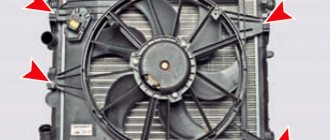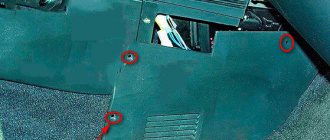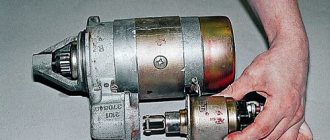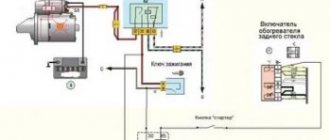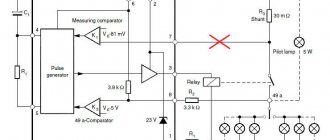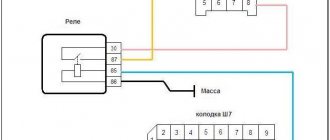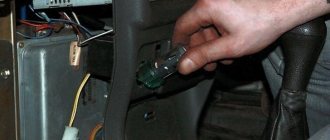Disabling locks using the service button in the cabin
If there are no signs of unintentional activation of engine start interlocks, you can try to unlock the engine using the service mode. This mode is called Valet and is used to transfer the system to service mode. To activate, you need to insert the key into the ignition, turn on the ignition and then turn it off.
After this, you need to hold the service mode activation button for about 10-20 seconds. The result will be a notification using a special short signal, after which the signal lamp (indicator light, LED) will be constantly on. This method means disabling all security functions, which may also mean removing the engine locks. We add that after fixing the problem, it is necessary to activate the security functions of the alarm again.
In some cases, emergency disabling of the alarm using a hidden button in the car interior also helps. The specified button is also held for 10 to 20 seconds, after which the alarm status LED lights up and then goes out. After the light goes out, you can try to start the engine.
Engine blocking with car alarm
If there are installed anti-theft systems, electrical equipment is responsible for blocking the engine start. Immobilizers or car alarms may turn out to be faulty and give constant or isolated failures during operation.
It should be added that the severity of the problem will depend not on a specific model or brand of car, but on the complexity of the installed anti-theft system.
Why does the starter turn normally, but the engine does not catch and does not start? The main reasons for the malfunction, checking the fuel supply and ignition systems. Adviсe.
Accidental activation of the engine lock function
First, carefully study the displayed icons on the alarm key fob. A common reason for blocking is the accidental activation of additional functions. You also need to monitor the LED readings (if present) in the car interior, which serves as a light indicator of the alarm status. The flickering of the LED lamp almost always indicates that the anti-theft function of the immobilizer is activated in the menu.
Unlock methods
Having installed an external alarm system, for example, Starline, it is advisable for the car owner to carefully study the instructions for the rules of its use and operation. The instructions also contain tips on what to do if there is a malfunction in its operation.
The easiest way to unlock an external alarm is to re-close the car doors. To do this, get out of the car and close the door tightly. Then turn on the remote control to arm the car and wait about ten seconds. It is during this time that the car is armed. On some types of alarm systems, the arming process takes longer, from one to two minutes. Open the doors again using the remote control and try to start the engine. If the failure occurs due to the door switches, hood, or trunk lid, then the car will start.
An attempt to return parameters to factory settings using the key fob can work effectively. Due to the fact that there are very many types of alarm systems installed on cars, and at the same time the settings algorithm is also varied, resetting parameters and returning to factory settings must be carried out according to the instructions.
Situations arise when the central unit does not respond to commands sent by the key fob. In this case, you can use the Valet service button. The button may be located in a secluded place, where the hijacker will not find it and it will take time to find it through the wires.
The location of the Valet button is indicated in the description, but often installers choose its location at their own discretion. It is recommended that after installing the alarm, you check with a specialist in what place he placed it. Forgot to ask or bought a used car, and then there were problems with the signaling. No problem - the service button is easy to find along the wires coming from the central unit.
If the alarm system is blocked so that not only the engine does not start, but the doors do not open, then you need to open the door lock with the key. Opening the door will automatically trigger a loud sound alarm, which can be turned off by disconnecting the terminal from the battery. Using the dialing method or using a diagram, the terminal numbers on the central unit and the color of the wires are determined. Using this information or visually using wires with the corresponding color, we find the location of the button.
Switching to service mode (or unlocking) is individual for each type of anti-theft system. Therefore, how to use the Valet button is described in the manufacturer’s instructions. Basically, all actions are almost the same for most types of alarms.
Here is an example of Starline deactivation:
- Open the car with the key.
- Turn on the car's ignition and press jack three times (time limited to 20 seconds).
- Turn off the ignition.
- The siren will sound and the emergency lighting will turn on at intervals.
- Starline deactivation is complete.
- Start the engine.
Other symptoms of engine failure due to alarm
Before going to a car service center, you can try to fix the problem yourself, which is manifested by the lack of startup after the alarm rings. Perhaps the reason is so banal that finding it will not be difficult.
- Inspect the contacts and all wires of the central unit. Oxides formed due to chemical reactions of dissimilar metals and water conduct microcurrents very poorly. Oxidation can be cleaned with a soft metal brush and treated with a water-repellent liquid. Inspect the wire that has fallen out of the connector (the metal retainer may be broken or pressed too hard against the connector) and try to repair or replace it.
- Check whether the relay clicks when arming or disarming. If the relay does not operate, replace it with a new one.
- If the wiring from the central unit is shorted, check the mounted fuses located near the central unit.
- When the alarm goes off, and this is manifested by incorrect operation of the central locking or the absence of flashing headlights or emergency lights, it is necessary to check the fuses of the corresponding electrical circuits and the switching relay.
An alarm system is a complex technical product and finding its malfunction is not easy. Sometimes at service stations, specialists get together and hold a consultation, solving the problem of why the security system blocks the engine from starting. The main thing is that if such a malfunction occurs, the car owner makes the right decision and either acts independently or contacts specialists.
The alarm won't let you start the car. What to do?
What to do if the car does not start due to alarm
Excellent alarm system. reliable protector against car theft. With all this, we cannot talk about 100% protection of the car from theft and disassembly. Any alarm, even banking, can be broken. Another issue is that it will take time. The better the alarm , the longer the time and complexity of hacking. Thieves inadvertently raise the issue of breaking a machine with a good alarm if you can choose a more conventional "job".
Like all electrical devices, a car alarm can become faulty over time, or at the moment it's stylish to say "glitchy." At the same time, it either does not disturb the car, or accidentally starts it, or, even worse, blocks the authorized (from the original key fob, tag or other programmed mode) disarmament, and blocks the engine from starting. What to do in this case?
Possible reasons for blocking the engine start alarm
The main causes of engine starting failures associated with alarm blocking are:
The above conditions are mandatory only in case of alarm shutdown of the machine, however, do the machine. no gives .
The inclusion of a low battery in this list is because the code message for the main alarm may be garbled or incomplete when the low voltage indicator is removed. The car may disarm and the door will open, but other functions may not work. Therefore, most motorists begin to eliminate disturbance interference by replacing the battery in the remote control, and rightly so.
Problems in the operation of at least any automatic alarm system, even a high-quality one, begin to appear after five to seven years of operation. The increase in this period depends, firstly, on the property of his institution. There are cases when simple Chinese modules work continuously for more than 15 years.
what to do if the car does not start due to alarm
First, you need to find out whether the alarm is starting to lock up the engine or whether this problem is due to other reasons. In this case, it is recommended to diagnose the computer engine. Engine starting tasks may be associated with a standard immobilizer.
In BMW cars it can block the starter. In other models, the standard immobilizer closes the fuel supply circuit, the ignition. The engine may not start due to failure of other parts of the engine management system. Computer diagnostics will help with a clear diagnosis.
Engine blocking with car alarm
If there are installed anti-theft systems, electrical equipment is responsible for blocking the engine start. Immobilizers or car alarms may be faulty and cause constant or occasional failures during operation.
It should be added that the severity of the problem will depend not on the specific model or brand of car, but on the complexity of the installed anti-theft security system.
Accidental activation of the engine lock function
First of all, carefully study the displayed icons on the alarm key fob. A common cause of blocking is accidental activation of additional functions. It is also necessary to monitor the readings of the LED indicator light (if equipped) in the vehicle interior, which serves as a light indicator of the alarm status. Flashing LED lamps in most cases indicate that the anti-theft function of the immobilizer is activated in the menu.
If, after turning the key in the lock and turning on the ignition, the warning lamp blinks frequently (for example, the StarLine car alarm) before starting the engine, and a pictogram with the inscription “immo” is displayed on the key fob itself:
Measures taken in the absence of startup
The car alarms offered to car owners have a variety of service functions and an additional blocking system is installed on the unit specified by the customer. This could be a starter, fuel pump, engine control unit, automatic transmission, etc. If any of the engine blocks or components suddenly refuses to function, then it is necessary to determine the cause of the malfunction by connecting diagnostic equipment. Checking compression, sensors, fuel pressure and spark generation directly related to engine starting provides the final direction to look for a starting fault in the alarm system.
One of the reasons for the lack of starting may most likely be a malfunction of the standard anti-theft system (immobilizer).
The principle of operation of the immobilizer, in contrast to the external anti-theft system, is based on data exchange with the control unit, allowing or prohibiting engine starting without additional interlocks. Permission to start the engine is carried out only after successful initialization (reading the code) of the attached black key. If the car is not disarmed, then when you try to start the engine, the control unit will block the ignition system and the operation of the fuel pump.
Data exchange between the immobilizer and the electronic control unit occurs via K‑Line, so it is possible to disable it by simply connecting it to the diagnostic block of scanning devices with the ignition on.
The fact that it is the external alarm system that is blocking the engine start can be determined by the blinking of the control indicator, information on the key fob monitor, the constant operation of emergency lights (side lights or headlights), freezing and inoperability of the control panel buttons and the operation of the sound bell.
The alarm is blocking the fuel pump, what should I do?
And they - these algorithms - can be passive or active. Everything is the same as with well-known “minorities” - like relays and relays - and lo and behold - it can be “passive”, or maybe “active”. It depends on the algorithm (such as, on the environment, on upbringing) who will become who and what. The active blocking algorithm is the most vulnerable, because the blocking relay with such an algorithm in a de-energized state allows the engine to start. This type of blocking is otherwise called “normally closed ", or simply NC - according to the type of blocking relay contacts in the "Security" mode. A typical implementation diagram of NC engine blocking is illustrated by the fragment of the connection diagram of a standard Taiwanese alarm shown in Fig. 2 - generally NC blocking is liked to be used by manufacturers who have narrow eyes from birth .
In the “Disarmed” mode, there is no voltage on the blocking terminal, and therefore on the relay winding, and the relay, with its NC contacts (contacts 87a and 30), allows the engine to start. More precisely, it does not prevent this. In the “Security” state, there is a ground potential on this wire, and when you try to start the engine, a plus from the ignition switch will appear at the second end of the winding, the relay will switch, thus prohibiting the operation of the starter, in this example.
To neutralize active blocking, obviously, it is enough to simply de-energize the alarm module in any way. For example, by pulling out all the connectors from the module, or simply breaking the wires, and often it is enough to remove the system fuses from the holders. And that’s it – nothing can stop you from starting the engine. This is the main reason why I can’t stand blocking NC by relay contacts.
With a passive algorithm, a blocking relay prohibits engine operation in a de-energized state; the contacts of such a relay are normally open (blocking is therefore called NR).
This means that to remove the lock, you need to apply voltage to the relay, it will switch, and the engine can be started.
In Fig. Figure 3 shows an example of a standard blocking of an injection engine fuel pump by an alarm.
As can be seen from the diagram, the blocking relay breaks the control circuit of the standard fuel pump relay, so the current through its contacts is small, which allows the use of a low-power, and therefore small-sized relay.
At the same time, the theft resistance of such a simple blocking is low; it is usually bypassed by applying voltage directly to the fuel pump using a jumper.
You can slightly improve the quality of blocking by adding another blocking relay (Fig. 4), breaking the power supply wire of the pump with its contacts.
In this case, it is advisable to partially remove the standard power wire, laying your own wire in its place - you will get a so-called “spaced” blocking - it will be even more difficult for scoundrels to repair the break. Especially if the second relay is installed directly in the fuel pump hatch, as illustrated in photographs 5, 6, 7 and 8.
Rice. 4. (above) A resistor is used to make it difficult to diagnose a “fault” (specifically, here it is more to illustrate the principle), but diodes are needed so that a short to ground of the blocking wire directly at the relay does not turn off the entire blocking.
Rice. 5. The photo shows the fuel pump connector and its supply cable. The blocking relay breaks the power wire, and applying voltage using a jumper to the wires in the cabin will not have any effect - you will need to unscrew the fuel pump hatch cover, and we can use non-standard screws to make this more difficult.
Rice. 6. The relay is carefully hidden under the bottom of the trunk, so that after installing the cable in place, the relay would not be visible.
Fig.7. The cable is in place - but where is the relay?
Rice. 8. After screwing the lid back on, it is not easy to guess about the “bug” living under it.
The most important advantage of the HP blocking is that even if you de-energize the alarm using the above methods, this will not help - to neutralize it, it is already necessary not only to de-energize the system, but also to connect the blocking output of the alarm to ground. To make things even more difficult for hijackers, the developers integrate a blocking relay inside the alarm module.
An example of such a blocking is shown in Figure 9 - the built-in relay breaks the high-current power supply circuit of the fuel pump - and to bypass the blocking in this case it is necessary to restore the break.
Thus, it is easy to see that the HP interlock is better at resisting thieves - they must find the necessary wires in the alarm harness and connect them together.
Or find the ground wire on the alarm connector, disconnect it and connect the remaining wires together. In general, this is already more complicated than tearing the alarm unit out of its connectors. But it's still simple.
Super post. There is just an awesome amount of information (Starting with the fact that there is a whole sea of “Scorched Cats” (Ts) (and the whole sea is that they don’t drown in water) and ending with the description of the wiring. Here, you know, there are no psychics. Everyone is on unpaid leave for your own account. At least I could post pictures of the key fob and wiring. It would be clearer that way. Otherwise, no one will tell you anything specific. Again, the question is, did the alarm settings go off for an hour? Well, like the car was parked for a long time and the battery went to zero or something like that before that there were no wires? And if it’s tied up “makeshift”, then unwind the electrical tape, figure out what and how it’s connected there, clean it up and screw it back in. The simplest thing, for starters.
Sincerely. PS Pictures can be posted on bestpics.ru, just check the box, which does not apply to humor.
PS Undercut wiring can even “kill” the system. Those. You will have to constantly + throw it on the fuel pump wire. The good news is that it looks like the twist has simply oxidized somewhere and the voltage across it drops so much that the relay no longer turns on. And where is that twist - well, who knows? But I would start looking under the hood under the duct tape.
PS It would also be nice to announce the color of the wiring. Finol with black stripes, for example.
Re: OK, something like this in your own words (photo tomorrow): > On the opposite edge of the glove compartment bracket there is a device, judging by its freshness, related to the signaling system. > It has the shape of a cube, at the bottom there is a chip with wires, at the top there is a rubber casing, and to the touch there is some kind of button under the rubber band on top of the device.
This is a standard pump shut-off valve when the car rolls over.
> From this device, a non-standard wire runs across the glove compartment (beige with a red stripe, as far as I remember), then this wire is simply twisted with the standard wire on which the insulation has been removed. It is definitely terribly corroded at the place where it was wound, the copper already looks like black dust, the insulation is hardened. > That is If I understand correctly, the problem could be a bad connection? And the first thing you should try is to clean everything to a shine and restore the twist again?
Yes, at least restore contact
Most likely this is the shit. Well, the simplest thing is to really clean it and reassemble it. When the resistance is higher than normal, the tester will still show +12 volts without load. This is school physics, I don’t remember what class there, about how voltage is divided by a resistive divider.
